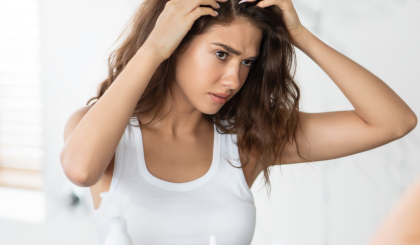Dandruff is a common skin condition that affects the hair and scalp. While it can be unsightly, the good news is it isn’t contagious, and can be resolved at home with special shampoos.
Here, we’ll explore the common causes of dandruff, as well as outlining some of your options. That way, you can understand how to manage a dry and flaky scalp.
In this guide:
What is dandruff?
Some of the most common symptoms of dandruff include white or yellow flakes which are visible in your hair or on your shoulders, along with a dry and itchy scalp.
While dandruff typically affects the scalp, it can occur on any area of the body that has hair. This can include the eyebrows, eyelashes and chest. You may notice itchy, dry and scaly patches of skin occurring in these areas.
Most cases of dandruff will not need to be diagnosed or treated by a doctor. However, you may wish to consult your GP if the condition doesn’t improve after home treatment, or if your scalp becomes swollen, red, or very itchy.
What causes dandruff?
Contrary to popular belief, dandruff is not caused by poor personal hygiene. However, the symptoms may be more visible if you do not wash your hair regularly.
There are several scalp conditions which can lead to dandruff – each of which may result in slightly different symptoms. These include:
Seborrhoeic dermatitis – presents as scaly skin and itchy red patches on the scalp, face, and body.
Eczema – symptoms include dry, red, flaky skin on different areas of the body.
Ringworm – also known as tinea capitis, this shows as a red or silver rash and potentially patchy hair loss.
Psoriasis – the symptoms of psoriasis are red, flaky skin patches with silver-coloured scales, which may turn crusty.
Other possible causes and triggers for dandruff include:
Sebum – too much sebum, which is a natural oil produced by the scalp, can lead to dandruff.
Stress and fatigue – which can aggravate dandruff.
Cold weather – dandruff often gets worse in winter, especially when the weather is cold and dry.
What can you do about your dandruff?
As the main symptom of dandruff is dry, flaky skin, it can usually be controlled by keeping the scalp clean and hydrated. Here are some different steps you can take to tackle dandruff:
Brush your hair regularly
A build-up of natural oil and dead skin cells on the scalp can lead to dandruff. So, something as simple as brushing your hair can help reduce it and keep your hair healthy. Brush your hair from the scalp down in a firm, steady motion to move the oil away from your scalp. Brushing your hair before washing your hair will help loosen the flakes and facilitate its removal.
Use special anti-dandruff shampoos
Using a specially formulated anti-dandruff shampoo can be an easy and effective at-home anti-dandruff option. These usually contain certain active ingredients, such as:
Coal tar
Salicylic acid
Piroctone olamine
Pyrithione zinc
Selenium sulphide
Ketoconazole.
If one of these ingredients doesn’t work for you or becomes less effective over time, it might be worth switching to another type of anti-dandruff shampoo. You should typically use anti-dandruff shampoo between once a day to a couple times a week, depending on your hair type and needs. Refer to the packaging instructions for more guidance.
Tailor your haircare routine
Your hair care routine, the way you wash your hair, and how frequently can help to keep your scalp healthy as well as your hair. How often you should use anti-dandruff shampoo will depend on your hair type. Only a small number of people will need to shampoo their hair every day. This includes people with an oily scalp, very fine hair, those who exercise and sweat a lot, and those who live in a humid climate.
Shampoo works by trapping the natural oils of the hair and scalp, so shampooing too frequently can lead to dry hair which can become prone to breaking.
Try to use fewer products
Certain hair styling techniques and products could also leave a residue and cause your scalp to become flaky with dandruff. Similarly, your skin may react to an ingredient and become flaky in a way that looks like dandruff. If you experience a flaky scalp, you may want to try switching to another product.
Get some sun
Natural sunlight can help suppress the growth of a fungus that is linked to dandruff. So, spending some time outdoors could help resolve your dandruff. Just remember to protect your skin by using a sun cream with an SPF of at least 30.



